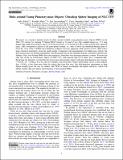Files in this item
Disks around young planetary-mass objects : ultradeep spitzer imaging of NGC 1333
Item metadata
| dc.contributor.author | Scholz, Aleks | |
| dc.contributor.author | Muzic, Koraljka | |
| dc.contributor.author | Jayawardhana, Ray | |
| dc.contributor.author | Almendros-Abad, Victor | |
| dc.contributor.author | Wilson, Isaac | |
| dc.date.accessioned | 2023-04-19T09:30:05Z | |
| dc.date.available | 2023-04-19T09:30:05Z | |
| dc.date.issued | 2023-05-01 | |
| dc.identifier | 284257061 | |
| dc.identifier | dc4efc96-136e-44f7-bc93-2335f22284df | |
| dc.identifier | 85152786469 | |
| dc.identifier.citation | Scholz , A , Muzic , K , Jayawardhana , R , Almendros-Abad , V & Wilson , I 2023 , ' Disks around young planetary-mass objects : ultradeep spitzer imaging of NGC 1333 ' , Astronomical Journal , vol. 165 , no. 5 , 196 . https://doi.org/10.3847/1538-3881/acc65d | en |
| dc.identifier.issn | 0004-6256 | |
| dc.identifier.other | Jisc: 1019260 | |
| dc.identifier.other | publisher-id: ajacc65d | |
| dc.identifier.other | manuscript: acc65d | |
| dc.identifier.other | other: aas44183 | |
| dc.identifier.uri | https://hdl.handle.net/10023/27429 | |
| dc.description | Funding: V.A. and K.M. acknowledge funding by the Science and Technology Foundation of Portugal (FCT), grants Nos. PTDC/FIS-AST/7002/2020, UIDB/00099/2020, and SFRH/BD/143433/2019. | en |
| dc.description.abstract | We report on a sensitive infrared search for disks around isolated young planetary-mass objects (PMOs) in the NGC 1333 cluster, by stacking 70 Spitzer/IRAC frames at 3.6 and 4.5 μm. Our coadded images go >2.3 mag deeper than single-epoch frames, and cover 50 brown dwarfs, 15 of which have M9 or later spectral types. Spectral types >M9 correspond to masses in the giant-planet domain, i.e., near or below the deuterium-burning limit of 0.015 M⊙. Five of the 12 PMOs show definitive evidence of excess, implying a disk fraction of 42%, albeit with a large statistical uncertainty given the small sample. Comparing with measurements for higher-mass objects, the disk fraction does not decline substantially with decreasing mass in the substellar domain, consistent with previous findings. Thus, free-floating PMOs have the potential to form their own miniature planetary systems. We note that only one of the six lowest-mass objects in NGC 1333, with spectral type L0 or later, has a confirmed disk. Reviewing the literature, we find that the lowest-mass free-floating objects with firm disk detections have masses ∼0.01 M⊙ (or ∼10 MJup). It is not clear yet whether even lower-mass objects harbor disks. If not, it may indicate that ∼10 M Jup is the lower-mass limit for objects that form like stars. Our disk-detection experiment on deep Spitzer images paves the way for studies with JWST at longer wavelengths and higher sensitivity, which will further explore disk prevalence and formation of free-floating PMOs. | |
| dc.format.extent | 8 | |
| dc.format.extent | 724303 | |
| dc.language.iso | eng | |
| dc.relation.ispartof | Astronomical Journal | en |
| dc.subject | QB Astronomy | en |
| dc.subject | 3rd-DAS | en |
| dc.subject | MCC | en |
| dc.subject.lcc | QB | en |
| dc.title | Disks around young planetary-mass objects : ultradeep spitzer imaging of NGC 1333 | en |
| dc.type | Journal article | en |
| dc.contributor.institution | University of St Andrews. School of Physics and Astronomy | en |
| dc.contributor.institution | University of St Andrews. St Andrews Centre for Exoplanet Science | en |
| dc.identifier.doi | 10.3847/1538-3881/acc65d | |
| dc.description.status | Peer reviewed | en |
This item appears in the following Collection(s)
Items in the St Andrews Research Repository are protected by copyright, with all rights reserved, unless otherwise indicated.

